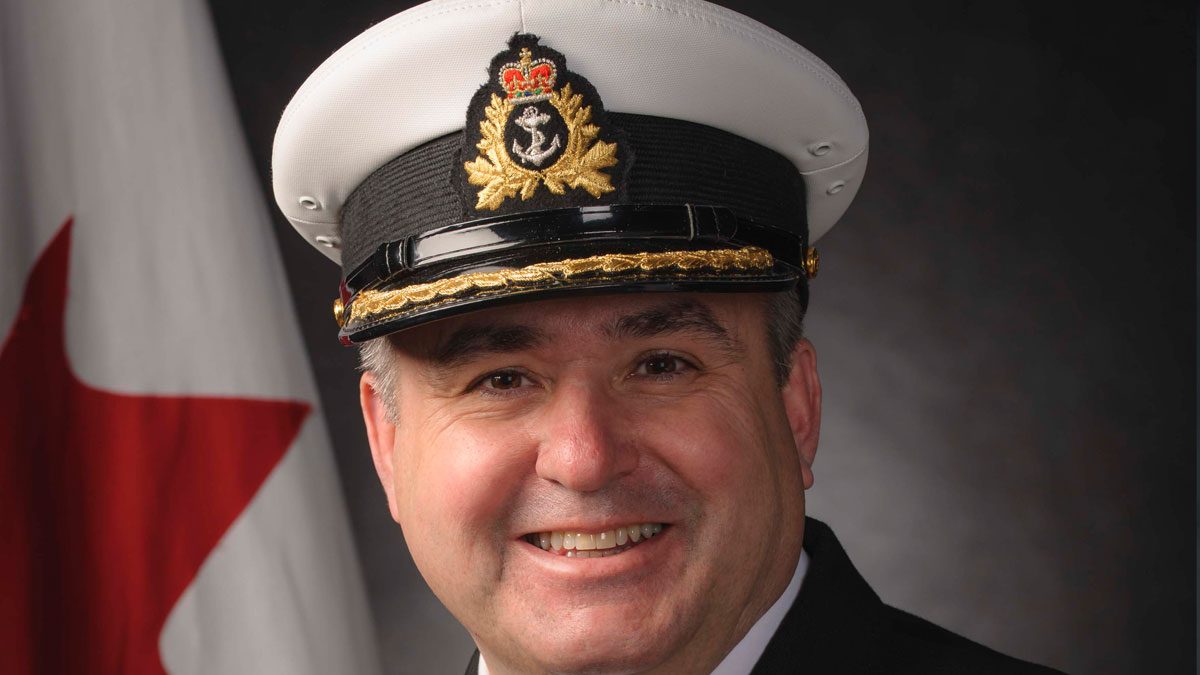In 2015, Cdr Corey L.E. Gleason was appointed the Commanding Officer of the future HMCS Harry DeWolf, the first of six Arctic Offshore Patrol Vessels that is being built for the Royal Canadian Navy (RCN) through the National Shipbuilding Strategy (NSS).
Cdr Gleason has a wealth of knowledge and experience that he brings to his current role by serving in different positions in the RCN for over three decades.
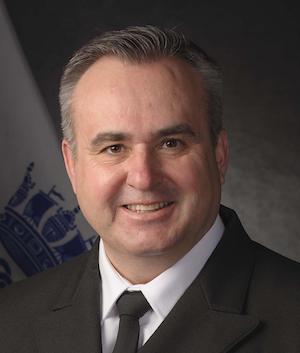
Originally from Welland, ON, Cdr Corey Gleason joined the RCN in the summer of 1985 and began his training as a Naval Signalman in Esquimalt B.C. He was assigned to HMCS Protecteur in Halifax N.S. upon completion of his training. While in Halifax, he served in multiple ships, participated in many other NATO exercises, and was support staff to Standing Naval Force Atlantic. In 1991, he was recruited to the West Coast to serve in the Training Squadron. While serving in Esquimalt B.C., he was crew to several ships including HMCS Ottawa where he deployed for Operation APOLLO in support of the war on terrorism.
Cdr Corey Gleason commissioned from the ranks in November 2003 and on completion of formal Officer Training in College militaire royal de Saint-Jean, NOTC VENTURE and HMCS Whitehorse, he served as Deck Officer, Navigating Officer and Combat Officer in every class of ship in the Maritime Pacific.
Cdr Gleason demonstrated a passion for the Arctic early in his career as a Navigator and was given his first opportunity to proceed to the Western Arctic in summer of 2009. It was there where he met his Arctic Mentor, CCG Commander (retired) Norman Thomas, who has worked with Cdr Gleason throughout the years as Gleason honed his skills and proficiency to command an Arctic Offshore Patrol Vessel.
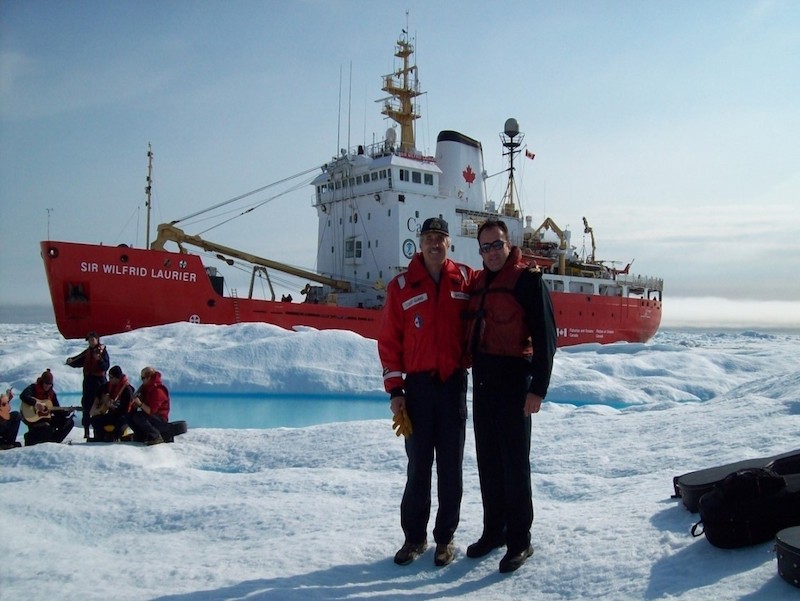
Cdr Gleason went on to serve in Sea Training Pacific as Weapons Officer and took up his first command appointment to command HMCS Yellowknife. He proudly served as a roving ambassador to the City of Yellowknife and the Peoples of the North-West Territories and visited the City of Yellowknife before he was appointed Executive Officer to HMCS Ottawa. Cdr Gleason reported for duty in HMCS Ottawa and immediately deployed to join the fight against the illegal distribution of narcotics in South America as well as in North America, supporting Joint Interagency Task Force South. After delivering the ship into dry dock, Cdr Gleason was reassigned to Sea Training Pacific and appointed Executive Officer.
As Executive Officer to Sea Training Pacific, he served on both coasts contributing to the RCN’s force generation and employment plans to support the employment of combat capable, multi-purpose maritime forces to meet Canada’s defence needs.
Cdr Gleason has continued his work and studies in the Arctic domain and has been developing RCN policy and procedures for future Arctic naval operations throughout his years of service.
Cdr Gleason and his spouse France Chalifour of Quebec City are very proud to be part of Canada’s naval history as he assumes command of Canada’s first of class Arctic Offshore Patrol Vessel. Cdr Corey Gleason and his spouse currently reside in Halifax N.S. where they have the honour and privilege to acknowledge his appointment to command the future HMCS Harry DeWolf.
Recently, Vanguard had the honour to speak with Cdr Gleason to get his take on the future HMCS Harry DeWolf, the largest RCN ship built in Canada in the last five decades.
Cdr Gleason, firstly, thanks for taking the time to speak with us. It must be exciting to be given the opportunity to be the Commanding Officer of the future HMCS Harry DeWolf. How would you describe your initial thoughts when you were appointed as the Commanding Officer?
Firstly, I was incredibly honoured to have been given the responsibility to help enable the RCN’s transition to the future fleet in this special way. While the RCN has been able to conduct operations in Arctic waters in the past, the future HMCS Harry DeWolf and the other ships in its class represent a huge leap forward in terms of Canada’s ability to preside over and monitor its northernmost waters. In saying this, the opportunity to lead the first-of-class vessel represented a leadership challenge like no other. Not only would I need to work tirelessly to become a subject matter expert in Canada’s arctic and its sovereignty, but I would also be expected to lead my team of 78 sailors to do so as well. Everything from the procedures dealing with maneuvering the ship to relationships between the Harry DeWolf-Class and its Coast Guard counterparts had to be built from the ground up – not to mention building an understanding of the cultural aspects related to co-operating closely with Canada’s northern Indigenous communities. I knew the experience would require long hours and much personal and professional development, but ultimately, I knew that serving Canada in this capacity would be one of the more rewarding experiences in my career.
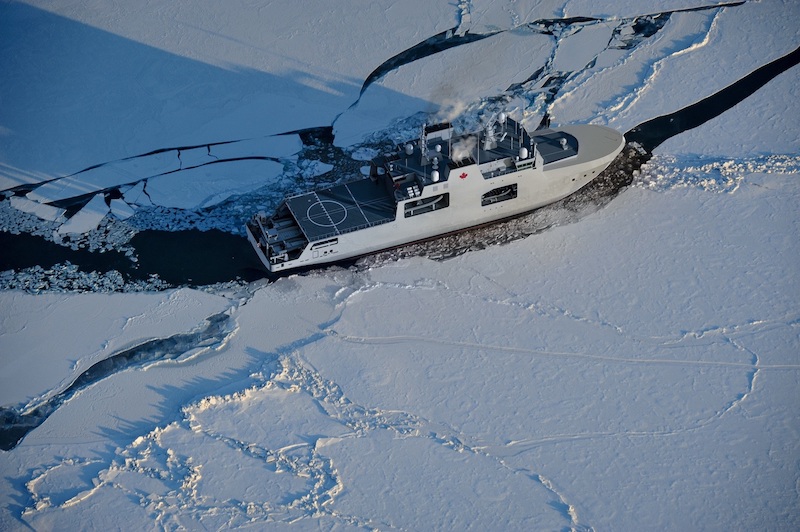
What are some of the capabilities that you are looking forward to in the new fleet of the Arctic and Offshore Patrol Vessels?
I would say that I am most excited for the wide array of capabilities of this class of vessel and its ability to provide support to the RCN in most facets of domestic maritime operations. The Harry DeWolf-Class AOPV will be capable of operating in a range of environments that extend far beyond Canada’s arctic waters. In addition to ice operation, the Harry DeWolf-Class will be capable of patrolling the entirety of Canada’s Economic Exclusion Zone (EEZ) as well as the Great Lakes, the Caribbean and coastal Central America. The class will be able to increase the RCN’s Maritime Domain Awareness (MDA) though its ability to operate in all of Canada’s waters all while playing host to multiple assets. These assets include Naval Tactical Operations Group (NTOG) teams and RCMP Law Enforcement Detachments (LE Det) as well as teams from the Department of Fisheries and Oceans (DFO) and the Canadian Coast Guard (CCG) for the purposes of enforcing Canadian law and supporting Other Government Departments (OGD). These vessels will also be able to carry the supplies and personnel required to participate in Humanitarian Assistance and Disaster Relief (HA/DR) operations.
How are the AOPVs shaping up to meet the expected missions of protecting Canada’s sovereignty in the North, defending North America with our allies and contributing to international security, particularly in the areas of supply and endurance?
Ultimately, the AOPV’s role in protecting Canada and contributing to international security is presented in its ability to operate in all waters surrounding North, Central and South America. Not only does the hull itself allow for increased operation in the Arctic and continued operation around the continent but added technical and physical components of the vessels will be instrumental in helping the RCN meet the expectations of a range of missions.
AOPVs will feature a CH-148 Cyclone helicopter, deployable motor vehicles, Rigid-Hulled Inflatable Boats (RHIBs), Electro-Optical/Infrared (EO/IR) cameras, surveillance radar systems, satellite communications, fully integrated navigation systems, medical facilities, and quarters for briefing and housing special teams from the Canadian Armed Forces (CAF) or OGD. All of these combine to create an excellent platform that advances the RCN’s and CAF’s command and control (C2) capabilities in the Arctic, our other territorial waters, and abroad. The AOPVs will be able to extend Canada’s reach both physically and strategically, and they will bring a swath of modern technology to any operation they find themselves involved in.
What roles or missions do you see the AOPVs participating in the offseason?
When the AOPVs are not conducting operations in the Arctic, they will be engaged in many activities around North and Central America. These activities include but are not limited to: Civil-Military Cooperation; Aid of the Civil Power in times of crisis; coordination with OGDs such as the RCMP, Department of Fisheries & Oceans or Canadian Coast Guard; supporting Department of National Defence (DND) activities and exercises or HA/DR in domestic crises. The HA/DR capabilities of the class can easily be extended internationally during crises such as the 2010 earthquake in Haiti. AOPVs can also participate in Operation CARIBBE/Operation MARTILLO in cooperation with international navies and the U.S. Coast Guard to contribute to drug interdiction efforts in the Caribbean and eastern Pacific. Largely, I believe that AOPVs will continually be employed to monitor and facilitate control of maritime activities within Canada’s EEZ, no matter their task. They will continually contribute to maritime domain awareness by constantly building the recognized maritime picture.
In addition to this, the multitude of internal assets built into or integrated with Harry DeWolf-Class vessels makes them ideal platforms to conduct Search and Rescue (SAR) operations. Modernized optics, communications, boats and a helicopter will allow for an improved capability to reach out to vessels in distress. The class’ improved C2, along with its medical and logistical capabilities, allows it to provide an excellent potential platform to support a SAR incident on-scene commander.
Please describe some of the benefits Canadians will derive from the AOPVs?
In addition to increasing the RCN’s SAR capabilities that are inherent in an increased coastal and arctic presence, the AOPVs and their construction have played a large role in Canada’s economy. The longevity of this project, in combination with the future Canadian Surface Combatant project, will help eliminate the cycle of “boom and bust” in Canada’s shipbuilding industry.
As had already been reported in the media, from the mid-1990s until 2010, Canada’s shipbuilding industry had slowed significantly. There had not been any substantial new orders to construct vessels for many years. Compared to other countries, Canada’s shipyards were outdated and did not have easy access to equipment, supply lines and skilled workers. With the creation of the AOPV project, skilled workers who are able to remain in one location for a whole 20 or 30-year career were attracted to the Maritimes with the possibility of advancement in the industry. With these new opportunities came an improvement to the economic stability of countless Canadians.
This project also directly contributes to Canada’s defence policy Strong Secure Engaged. These ships allow us to be strong at home while patrolling our arctic waters, secure in North America by contributing to regional security through humanitarian assistance and drug interdiction, and engaged in the world through our lasting cooperation with arctic allies such as Denmark and Norway.
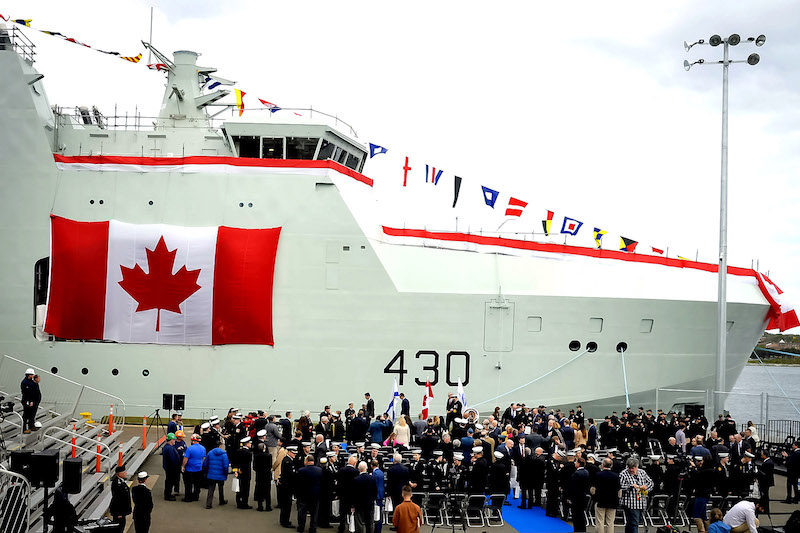
When can we expect to see the first foray into the Arctic by the RCN in an AOPV?
In short, we can expect our first venture into the Arctic to take place approximately 12 months after the first ship is delivered to the RCN. With this being said, a plan exists to trial the future HMCS Harry DeWolf’s range of capabilities through a circumnavigation of North America. The ship will experience the Canadian Arctic as well as the tropical waters of the Caribbean, and it will be introduced to the Canadian public on both coasts as well as in our Arctic communities while it transits the Northwest Passage. Also, the potential exists for the ship to conduct Maritime Interdiction Operations while operating both west and east of the Panama Canal. This would prove a variety of capabilities, including the functionality of the ship in relation to the CH-148 Cyclone as well as the ability to integrate a Law Enforcement Detachment.
How is the RCN going to work with the Canadian Coast Guard as it relates to operating in the North, particularly in ice? What sort of agreement is in place or what’s the relationship like?
The RCN and the CCG are two sides of the same coin – indivisible in looking after the safety, security and defence of our great nation. Most recently, a joint RCN/CCG Concept of Operations was signed which will serve to reinforce sovereignty while ensuring the security and protection of the Canadian Arctic. It jointly ensures our activities are coordinated while we fulfill our different roles in Canada’s Arctic. The RCN has also been enthusiastically taking advice from and conducted training with the CCG in order to build navigation and seamanship expertise in ice.
What is certain is that both the RCN and CCG will be working closely together in order to ensure safety of navigation in the North and the security of Canada’s arctic sovereignty. We will continue to support one another’s operations in the maritime domain and we will strive towards interoperability of our organizations. I am confident the existence of AOPVs in Canada’s Arctic will strengthen the bond between our two organizations.
What input has the RCN taken from native peoples (Inuit)?
Canadian Rangers are the eyes and ears of the North, and they are routinely integrated into CAF exercises and operations in the Arctic, demonstrating the strong relationships between the CAF, RCN and the northern communities. The Rangers extend the CAF’s reach into remote areas of the region year-round and provide a wide range of experience in operating in such an austere environment. When operating north, the CAF and RCN gain valuable expertise from the Inuit and peoples of the North on land and at sea. Looking forward, once Harry DeWolf-Class is in full service, I personally look forward to the opportunity for the Inuit and peoples of the North to be personal advisors and serve in naval uniform in AOPVs, in a similar way the Canadian Rangers serve to support the Canadian Army and CAF as a whole.
What are some of the potential issues arising from eco-tourism (SAR/environmental)?
As global temperatures rise and the Arctic undergoes further ice melt, shipping lanes begin to open where ice once existed. This allows for increased eco-tourism, arctic cruises and potentially permanent shipping routes through the Northwest Passage. The increase in activity will inevitably cause an increase in situations requiring SAR, as well situations that might pose a risk to the environment (fuel spills, oil spills, etc.). The RCN’s AOPVs will be able to lead both SAR and environmental responses through our increased reach and improved C2, medical and logistical support capabilities. It is possible that, in the event of an environmental disaster, AOPVs will be able to host environmental assessment teams and cleanup crews in order to transport them to and from the impacted area.
What is the potential for HA/DR in the DeWolf-class AOPVs?
Harry DeWolf-Class AOPVs will greatly increase the RCN’s ability to respond to HA/DR-related scenarios. As stated previously, each vessel will be equipped with medical facilities, briefing and staging areas, and a variety of vehicles and boats that will allow us to respond to stricken regions both offshore and inland. The class also has a large flight deck which will support a CH-148 Cyclone helicopter. In addition, the ship can be fitted with multiple sea containers which can hold anything from emergency supplies to living quarters for personnel specializing in HA/DR response. This class will surely increase the RCN’s capabilities to reach out to those in need around the continent.
Regarding the AOPVs, what’s the feedback like from discussions with your American and Danish counterparts?
The feedback we have received about the vessel, its capabilities and the RCN’s AOPV program in general has been resoundingly positive. In fact, as a result of this program’s success, there have been multiple times where I have been asked to speak at engagements about this exciting new capability for the RCN. It is an exciting time in the realm of AOPVs, and that excitement is echoed through the interest in our program by arctic member states.
How does the ships’ leadership intend to keep the crew occupied and entertained during long northern deployments given that port visits will be few and far between?
On deployment, it is incredibly important to maintain a work-life balance. This balance pays dividends in terms of maintaining the crew’s morale and operational effectiveness. While work hours will be filled with both training and patrols, off time on the Harry DeWolf-Class will allow the crew to relax. This is especially true given that the ship also acts as a sailor’s home away from home. These AOPVs are fitted with a cafeteria for all ranks to enjoy their meals as well as three separate lounge areas called “messes.” There is a specific mess for the Junior Ranks, one for the Petty Officers and Chief Petty Officers, and one for the Officers. These messes will be where the ship’s company will be able to enjoy their time off by watching movies and socializing. The ship is also outfitted with a gymnasium that will be full of fitness equipment. This gear will make it easy for the crew to remain occupied and also remain fit. The living quarters are set up so that there are no more than six personnel living in one space, and each of these accommodations houses a laptop or a computer that will allow the crew to keep in touch with family and friends back home. Lastly, this will be the first class in the RCN that will be initially fitted with WiFi in the living and social quarters. This will make it easier for the crew to keep in touch with family when the ship’s computers are being used by other sailors.
Finally, what’s next in the timeline for the future HMCS Harry DeWolf, and when can we expect the vessel to be delivered to the RCN?
The ship will be brought into service in summer 2019. In between then and now, the ship is still under construction. As it rests in the water alongside Irving Shipbuilding, the ship appears to be complete and ready for service, but once you get inside, you can see there is a lot of work left to do. The big parts are in place now, but cable runs need to continue, the technicians need to terminate all the lines and connect them to the machinery and electronic equipment, and following that a lot of test and trials must be run.
In fact, that will be the first job – test and trials – but you can bet that the ship will be put to work immediately, providing sovereignty through presence in Canada’s domestic waterways, and wherever there is a search and rescue requirement or interdiction operations by OGD that requires the unique capabilities of this ship, it will be ready to respond concurrent to the test and trials.

